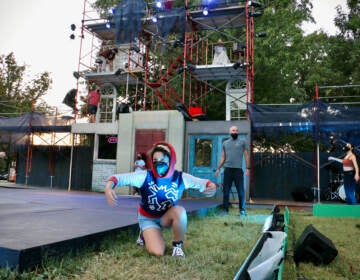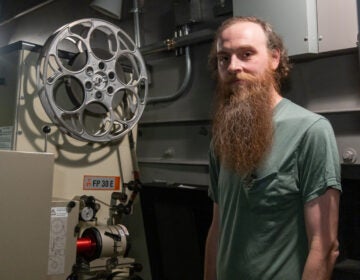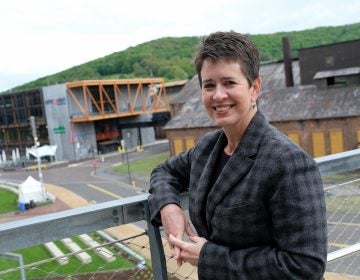Bethlehemites are ‘Starstruck’ by an art film about their own history
Lehigh University Art Gallery asked New York artist Shimon Attie to make “Starstruck,” a film and sculptural installation about the history of Bethlehem, Pa.
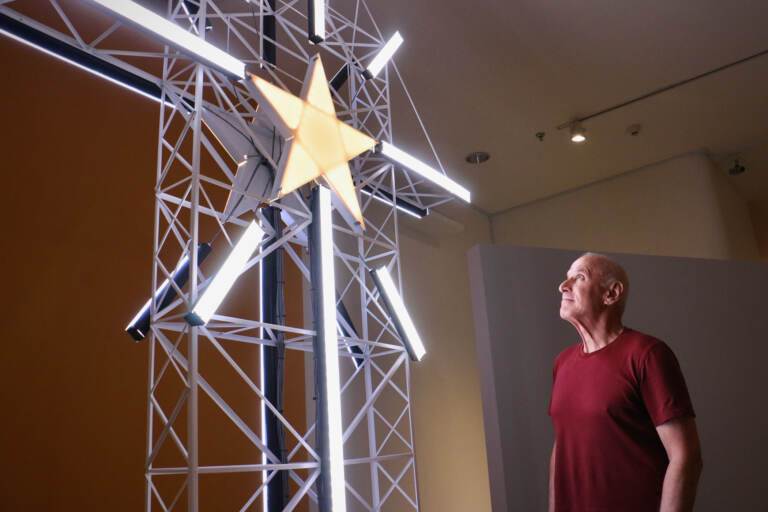
Artist-in-residence Shimon Attie created an 11-foot-tall replica of Bethlehem's 90-toot Star Tower for his exhibit at Lehigh University Art Galleries. (Emma Lee/WHYY)
The 281-year-old story of Bethlehem has been condensed into a 19-minute art film and sculptural installation at Lehigh University.
Called “Starstruck: An American Tale,” by artist Shimon Attie, the two-channel projection inside the university’s Art Gallery uses six local performers portraying different historical layers of their hometown: from its founding by Moravian Christians in the 18th century, to the dominance and deflation of the steel industry in the 19th and 20th centuries, to the rise of a gambling economy.
The New York-based artist was invited to Bethlehem in 2020 by the university through its artist residency program. He had never been to Bethlehem, Pa., but saw the city as a microcosm of the nation.
“That history of the pioneering idealism of the early days, later industrialization, complete collapse, disillusionment, and the urgency to then reinvent yourself,” said Attie. “Just the American dream of making it big by winning the slot machines. I think this is the American tale.”
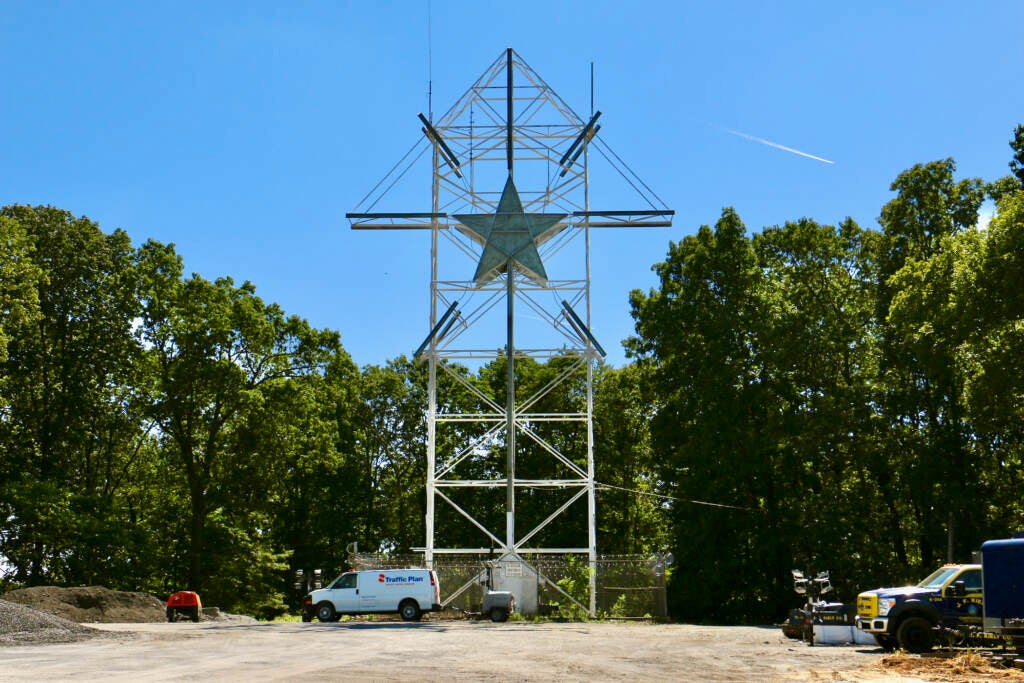
The film is constructed as a series of portraits in motion, with each character occupying a niche of Bethlehem: an 1741 Moravian woman in the city’s historic section, a man in a protective blast suit near the former Bethlehem Steel plant, a hospital nurse doing his rounds, a blackjack dealer laying down cards.
As the film progresses, the characters fall out of their historic lanes: the steel worker appears in a Moravian church; the nurse stares up at the rusted stacks of the steel plant; the blackjack dealer appears in front of Bethlehem’s iconic illuminated star atop South Mountain.
The film does not tell a story, per se, but rather shows different aspects of Bethlehem past and present. Then scrambles them up. Layers of history are condensed into the same time and space.
Between the two projection screens is an exact miniaturization of the Bethlehem Star, the 91-foot steel tower shrunk to about 11 feet. Attie says the star neatly encapsulates many of the themes he is working on in “Starstruck”: it references Christianity and the birth of Jesus Christ; it’s made of steel; and it was made in 1937 through an act of capitalism, created by the city’s Chamber of Commerce to brand Bethlehem as “Christmas City.”
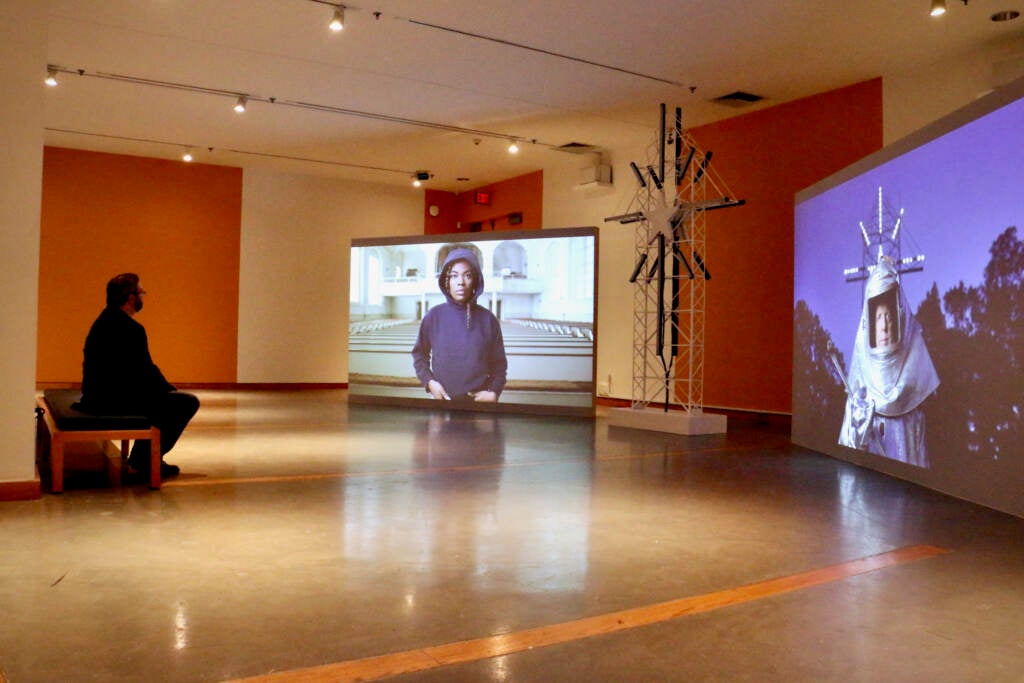
Instead of mimicking the illumination of the giant star on the mountain — which is steady, white light — Attie’s smaller structure lights up in an animated, multi-colored pattern similar to a gambling machine you might find in a casino.
‘We’re all Bethlehem, and this is all of our history’
“Starstruck” uses artistic techniques Attie has employed in other cities around the world, particularly places that have felt the boom and bust of industrialization, like a former steel plant in Luxembourg and the site of a coal mining disaster in Wales.
“For me, the best art remains complex all the way through. If it’s reduced to one simple message that’s not really an experience, that’s a piece of information,” he said. “I’m hoping to give people an experience, a way to reflect both on the specifics of Bethlehem, locally, but also on the American story, the very particular American brew of capitalism, religion, industrialization, and its collapse.”
To brew that concoction, Attie asked local talent to represent the different layers of the city. Most of the actors are playing versions of themselves: the nurse is actually a nurse, the steelworker is the grandson of a Bethlehem Steel worker, and the 18th century Moravian woman is Sarah Hriniak, who regularly portrays 18th century Moravian women.
“Portraying Moravian women of the time period is something that I do for fun,” said Hriniak who, when not teaching at Bethlehem’s Nitschmann Middle School, is a docent at the Moravian Historical Society in nearby Nazareth.
“I dress up in costume a lot,” she said. “That’s one of my favorite things to do.”
She even has her own historically accurate wardrobe, down to the weave of the linen, which she wears in the film.
“Sometimes I’ll portray specific characters in Moravian history,” said Hriniak. “I’ve portrayed Anna Nitschmann before. I’ve portrayed Benigna Zinzendorf before. But sometimes it’s just regular Moravian women of the time period.”
For “Starstruck,” Hriniak is not playing any specific historical figure. She said Attie asked her to wear period dress and try to look as neutral as possible: “not smiling, not having any particular expression or emotion.”
Hriniak kept a straight face, but in her head she let her imagination loose.
“What would a woman of the time period be thinking of if she could come to Bethlehem today and see this?” she mused. “How would she react? Would she be proud? Would she be amazed at what she’s seeing?”
We will never know if a Moravian woman would approve of how the town she helped found out of religious faith almost three centuries ago evolved the way Bethlehem did, but, for Hriniak, being part of the film project was “fantastic.”
“Shimon’s idea of having the steel worker standing in the church, or having the nurse practitioner standing at the steel stacks, having these people in places where you don’t think they would be … even if it doesn’t quite feel right, it’s all Bethlehem,” she said. “We’re all Bethlehem, and this is all of our history.”
That history of the city is in the performer’s DNA. The man who plays the steel worker, Vincent Doddy, comes from a long line of Bethlehem Steel workers: both of his grandparents, his father, his uncles, and his brother worked at the now closed plant.
Doddy, himself, never worked steel.
“My parents said, ‘Either you work for Bethlehem Steel or for Mack Trucks,’” he said. “I studied international marketing in college, so I went to work for Mack Trucks.”
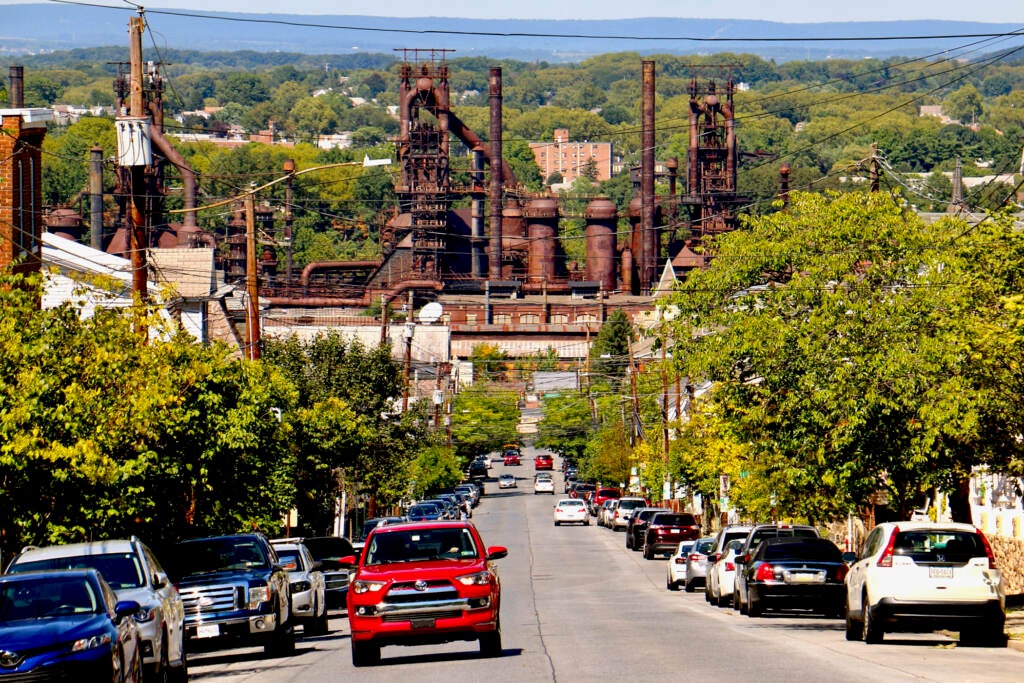
Doddy worked for Mack Truck for 38 years before retiring. He is now in the medical training field.
In the film Doddy appears in a bukly, silver suit that makes him looks like a nonplussed space alien investigating Bethlehem, but actually the fire retardant coverall would have been worn by men working the blast furnace, protecting workers from sparks and the intense heat of molding steel.
As with Hriniak, Attie told Doddy not to emote for the camera. But the suit made that impossible.
“If you look at my face it looks like I was hurting. Maybe because of the suit that I was wearing. It was really cumbersome,” said Doddy.
Doddy could not help but think of his family. His grandfather, also named Vincent, would have likely worn a similar suit.
“I channeled my grandfather,” he added. “I could just imagine him working with those beams after they came out of the blast furnace. I imagined the job that he had.”
Doddy said the visiting filmmaker “nailed it.”
“What impressed me was how Shimon could visualize an artistic concept in his mind and cast and direct normal people like myself who identify with that concept,” he said. “It was really an amazing film.”
“Starstruck: An American Tale” will remain on view in the Lehigh University Art Galleries until Dec. 3.

Saturdays just got more interesting.
WHYY is your source for fact-based, in-depth journalism and information. As a nonprofit organization, we rely on financial support from readers like you. Please give today.



